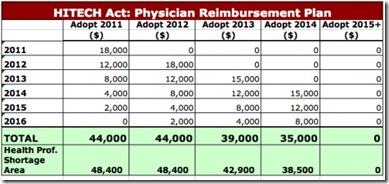The article about Pediatric Associates in CA has a nugget with a potentially outsized impact: the implication that VFC vaccines…
News 02/17/2009
From John Moore: "Re: HITECH. It’s certainly generating a lot of conversation. In one sense, this is great, getting docs to adopt, etc., but based on what I have read and what I am seeing so far, could become an unmitigated disaster. Just too much $$$ flowing into a market too quickly, a market that can not wisely absorb this largesse." Below is a chart John (of Chilmark Research) put together.
The bottom line for physicians is that the sooner a physician is "meaningfully" using a "certified EHR," the more money he or she is eligible to recoup. The definition of "meaningful" is not clear, but includes electronic prescribing, the exchange of health information for coordination of care, and the ability to report on clinical quality measures. Perhaps a bigger and more controversial question is what is a "certified EHR vendor"? The legislation does not specifically say "CCHIT-certified," but surely the vendors of currently CCHIT-certified products will claim that’s the way to go. Will CCHIT be flooded with certification applications? Or will the non-certified vendors expand their lobbying efforts to ensure their clients (and potential clients) get a piece of the monetary action? And, if you are a provider looking to purchase an EMR today, do you risk investing in a non-CCHIT solution?
While EMR vendors may have spent a couple of days rejoicing over the bill’s passage, most are now evaluating if they have adequate implementation resources. Something to ponder: EMR vendors may have to prepare for the liability involved if their users aren’t able to meet the "meaningful" use required. Perhaps this bill also provides some stimulus for attorneys.
If you are interested in learning more about the stimulus package and its effect on healthcare, HIMSS is hosting a number of Webinars that highlight various aspects of HITECH and its implications. If you are attending HIMSS09, you can also check out the 10 sessions that HIMSS has added on the topic.
Practice Fusion announces that it now has over 13,000 users of its free, Web-based EMR.
A Detroit columnist rails against Compuware’s hiring of Kwame Kilpatrick, disgraced former mayor of Detroit and a prisoner until a few days ago, as a $100K sales rep for its Covisint physician portal business. "What does Compuware’s hire of Kilpatrick say about Detroit, its politics and its corporate culture? That they keep rewarding failure, for one. Karmanos & Co. say Kilpatrick is ‘uniquely qualified’ for this gig, but his speedy hire, no-business and no-healthcare background suggest otherwise."
A New England Journal of Medicine report concludes that more physicians are moving away from careers as solo practitioners and instead are taking salaried position that ensure more financial security and shorter work hours.
Lara Bruneau, MD joins the PracticeOne Medical Advisory Council in Family Medicine.
Cleveland Clinic collaborates with MinuteClinic to provide clinical consultations as backup to nurse practitioners in nine northeast CVS in-store MinuteClinics. The arrangement includes integration of their respective electronic medical records, with patient-approved access to the clinic’s Epic MyChart information.
Panasonic reveals a new personal blood pressure monitor that includes an SD card slot. Patients can upload their readings to a PC, either their own or that of their doctor.
NuPhysicia launches inPlace Medical Solutions to provide medical services to offshore oil rigs and other remote workers. The solution connects the workers and physicians via live, two-way videoconferencing.
A Harvard PhD student brings PDAs loaded with the OpenMRS open source EMR to Peru, reducing TB test result times by 15 days.
Odd lawsuit: a woman taking generic metoclopramide claims she developed tardive dyskinesia and sues the generic manufacturer. The court dismisses her suit, so she sues original developer Wyeth instead, claiming it was "foreseeable" that her doctor read Wyeth’s literature. This new California interpretation of tort law now holds manufacturers responsible for the products of competitors.




Unfortunately the Medicaid section of the stimulus bill requires that any independent practice physician (not in a fed or rural clinic or assoc with a hospital) must have at least 30% Medicaid patients in their practice to get the incentive that would help with the costs of purchasing and implementing and EHR. Hardly any independent physicians will qualify for this as most are well below 20% Medicaid patients. Pediatricians have it a little better by only needing 20% but also get less incentive. The Fed and rural clinics have the huge advantage of being able to count uninsured and others towards the 30%. With these restrictions there certainly won’t be a flood of funding getting to any independent physicians any time soon (where 80% of care is given). They only have the Medicare pay for performance funds to hope for and those incentives only can be accessed AFTER they already invest and implement an EHR “meaningfully” (if they still are in business after the costs and the loss of productivity!)… I don’t think we are going to be seeing funds “flooding” anywhere but a lot of frustration instead.
Open letter to the HIT Standards Committee (as defined in the stimulus bill):
President Obama, our senators, and congressmen have spoken. Their goal is to increase healthcare efficiencies and interoperability. The HIT Standards Committee has a huge task in adopting, implementing, and certifying yet unannounced standards.
The livelihood and well-being of hundreds of thousands of physicians are at stake. The task is enormous.
The free marketplace has a way of sorting out these issues when provided an opportunity.
To date, interoperability testing of electronic medical record systems has been sparse and there is little precedence in how to achieve this task. The only example available is CCHIT, a costly program where operability, not interoperability, testing is the goal; where exclusion, not inclusion, is the result.
A new paradigm is needed where standards are published, test beds are made publicly accessible, and testing diverse functionality is segregated. It should not be an all-or-none phenomenon.
Using the example of the Continuity of Care Record (CCR) website, multiple CCR xml files are made available from a variety of vendors. Any vendor trying to achieve CCR interoperability can test against that set of data. There is no hefty fee to pay. Failure can be remedied by simple repair and retesting.
The National Council for Prescription Drug Programs (NCPDP) similarly makes available their e-prescribing SCRIPT xml files for testing. Any vendor who becomes a member has access to these files, is able to test, and become compliant in reading and writing the SCRIPT standard.
The National Library of Medicine provides the RxNorm database of normalized clinical drugs used in the United States and capable of being referenced in e-prescribing. Any vendor has unlimited access to this treasure of information.
The list goes on, but the important operative concept here is to publish these standards (and others), make them freely available to the public, and provide the open test beds to allow any vendor to test against the standards.
The free market, given this opportunity, will innovate and flourish. Inclusion, not exclusion, will allow electronic medical record software to flourish and the needs of hundreds of thousands of physicians to be met through competitive forces.
Thank you for your consideration,
Matthew Chase M.D.
Medtuity Inc.
Dr Chase: I heartily endorse your proposals concerning the direction that EMR certification should move. New technologies and imaginative business models are emerging in the EMR space, and the HIT Standards Committee should encourage these developments as you describe. In fact, your letter deserves more prominence (rather than a comment in a blog entry) – I would encourage you to submit your letter as a guest blog more prominently.
Robert Rowley, MD
Chief Medical Officer
Practice Fusion, Inc.
http://www.practicefusion.com